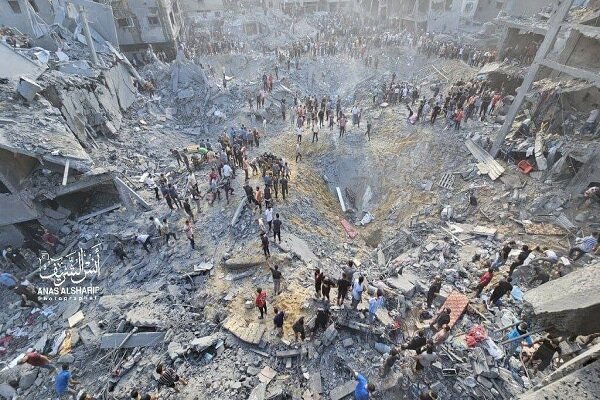Why did the Zionists return to the heart of the resistance?

| The resistance in Jabalia has now become a trump card and a symbol of the resistance's self-confidence. Analysts consider the resistance against the Zionists in the Jabalia camp to be a miracle. |
Mehr News, International Group: Jabalia camp is one of the oldest Palestinian camps, which was established in 1948 after the Nakba Day and the displacement of 750 thousand Palestinians in the north of Gaza City and on the road Gaza-Jaffa was built in a small area of 1.5 square kilometers and about 35,000 Palestinians, most of whom were from the north of the Palestinian territory such as Al-Lad, Jaffa, Ashdod and Beersheba, settled in it. Now this camp has more than 115 thousand people. Jabalia is derived from Jabal meaning mountain.
History of the “Mountain” camp
You hear the name of camps a lot these days. Since 1948, Palestinian refugee camps have become the center of Palestinian resistance; These camps have been the cause of effective resistance movements and have cultivated many resistance leaders. Ahmed Yassin, the most important founder of the Hamas movement, went to al-Shati camp with other members of his family after the Zionist militias destroyed his village. Fathi Shaghaghi, the founder of the Islamic Jihad movement, was born in the Rafah camp.
Jabalia camp is considered the center and spark of the first intifada, which became known as the Stone Intifada. The first intifada started in 1987 in Jabalia after the burial of the body of the three camp residents; These three people were martyred as a result of being run over by an Israeli driver at the Yzer crossing.
After settling a population in the Jabalia camp in the north of the Gaza Strip and near the northernmost city of this strip, Beit Lahia, Israel moved approximately 975 families of the camp’s residents to Beit Lahia camp was exiled near the borders of Jabalia camp. In 1971, the occupying authorities demolished and destroyed more than 3,600 rooms in which 1,173 families lived. The reason for these actions was the pretext of developing the camp roads to allow the entry of military vehicles for easy tracking of resistance members.
The Jabalia camp has been known and famous as a center of resistance especially since the 90s, and in different years various attacks and assassinations of the leaders of Saraya al-Quds (the military branch of Islamic Jihad) and Qassam We have seen (the military branch of Hamas) in this camp. In 2004, Israel carried out a military operation under the pretext of securing a buffer zone to protect Israeli settlements from the rockets of Ezzedine Qassam battalions and bombarded this camp for 17 days, which resulted in the martyrdom of more than 100 Palestinians and the displacement of more than of 600 people and hundreds of residential buildings and construction, health and service institutions were destroyed.
In 2005, Israel also targeted the military parade of Hamas in this camp with 4 rockets, after the official and complete withdrawal from this barrier, as a result of which 19 People, including two children, were martyred and around 80 others were injured. In July 2014, the Israeli occupation forces started a new massacre after bombing an UNRWA school in this camp where about 3,000 Palestinians were sheltering.
Jebalia after October 7
The Al-Aqsa storm on October 7 shocked and surprised the Zionists. The first massacre after October 7 took place in Jabalia on October 9, and more than 50 people were martyred in an airstrike. On November 18, 2023, another massacre of Zionists took place in Jabalia with the martyrdom of nearly 300 people. With the beginning of the ground attacks 20 days after October 7 and the barbaric bombings by the Zionists, which led to the martyrdom of about 10 thousand people, the Jabalia camp was declared one of the important targets of the army to reach the resistance leaders, tunnels and Zionist prisoners. /p>
It was the beginning of the second month of the war when the son of Gadi Eisenkot, the former chief of the general staff of the Zionist regime, was killed by a bombed tunnel explosion in Sheikh Zayed neighborhood in Jabalia. On the same day, one of the most important missile rains of the war hit Tel Aviv and Haifa with more than 100 missiles. An Israeli security source announced that the recent Qassam missile attack on Tel Aviv was carried out from Jabalia and Shojaiye neighborhood in the north of the Gaza Strip.
On the 70th day of the war, a big and lasting event happened in Jabalia, which the Zionists were forced to officially acknowledge. The Zionists admitted to mistakenly killing 3 captives after finding their place of detention in the Jabalia camp, and that news, along with Qassam’s clips of Merkava tanks exploding in this camp, was very shocking. But what was remembered in Jabalia was the Zionists’ astonishment at the non-evacuation of the camp by the people and the difficulty of its ground advance.
In March, when the war had reached its 126th day, with the complete retreat of the Israelis from the north, for the first time since October 7, Friday prayers were held in this camp next to the mosque. The camp was completely destroyed. After that, it was at the end of April that Jabalia returned to normal after a few months of conflict with the complete retreat of the Zionists.
Back again to Jabalia
The Zionist occupying army recently announced the beginning of the second phase of the invasion of the Jabalia camp; Where it is said that after the withdrawal of Israeli soldiers from this camp, Hamas has been able to rebuild itself in this camp. The goal of the Zionists in this action was their last attempt and chance to enter one of the important centers of resistance. The operation in Jabalia was a shock for the Zionists, and on average, it killed nearly 5 people per day (according to Qassam’s statements). The failure in Jabalia raised the voice of the critics and Hertsi Halevi, the head of the General Staff of the Zionist regime’s army, said: “The war against Gaza is inconclusive. We have fallen on the cycle of repetition! The army must attack Jabalia again, because there is no political movement for a power other than Hamas to rule the Gaza Strip.”
The Miracle of Jabalia
Regarding the miracle of Jabalia, Vahid Khadhab, an analyst of the Gaza war issues, writes: “When I was speaking with pure realism, both about the blows that the resistance received and the blows that it gave And in conclusion (again, completely realistic), I would say that Hamas, Islamic Jihad and other resistance groups are standing and standing in Gaza like the first day, some were mocking and mocking. However, after seven months of incredible bombings (several times the destructive power of the atomic bombs of Hiroshima and Nagasaki) and a ground attack with hundreds of thousands of cadres and reserves on a small barricade, now on the 220th day of the war, Israel is trying to advance only two or three kilometers deep into the Jabalia camp. It is slow, but it has faced heavy resistance and cannot, such a thing proves the validity of those conclusions. What is happening in Jabalia is a miracle that we do not see”.
The leaders of the Zionist regime thought that the strength of the fighters in the northern and central axes of the Gaza Strip had reached zero, and with this reasoning they attacked the city of Rafah, but their calculations were based on extensive defense. Resistance forces in Rafah and offensive operations in the north went wrong and suffered fatal and irreparable blows in the past days. In a report about the new stage of the Israeli army’s attack on the Jabalia camp in northern Gaza, Haaretz newspaper wrote that most of the regime’s soldiers consider the operation in this area pointless because they believe that Hamas quickly recovers its “massive capability” after each operation. and restores itself in other areas. Haaretz wrote that the operation in “Jabalba” showed that the army’s assessment regarding the destruction of Hamas infrastructure is not valid.
Summary
The resistance in Jabalia has now become a trump card and a symbol of the resistance’s self-confidence. Currently, only the southern areas of the Jabalia camp are occupied by the Zionists, and they have only been able to advance a little. Despite the bombings and destruction of more than 300 new houses in this camp, the resistant people of this camp still remain in it. Netanyahu correctly chose two symbols and places (Jebalia and Rafah) for the dramatic end of the victory before the ceasefire, but he has again miscalculated the strength of the Jabalia camp. The fate of Jabalia can cast doubts on Netanyahu’s and the war cabinet’s decision to attack the depths of Rafah city.
Mohsen Faezi; Regional issues expert


